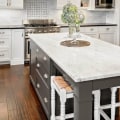When considering the most durable finish for kitchen cabinets, several factors come into play, including the material of the cabinets, the environment of the kitchen, and the expected level of use. Among the various finishes available, some stand out for their ability to withstand wear and tear, moisture, and frequent cleaning, making them ideal for the bustling environment of a kitchen.
One of the most durable finishes for kitchen cabinets is catalyzed conversion varnish. This type of finish is known for its superior resistance to moisture, chemicals, and physical impact. Conversion varnish is a two-part synthetic resin that, when catalyzed, creates a cross-linked bond that is incredibly tough and resistant to damage. This finish is often applied in professional spray facilities and requires precise mixing and quick application, but the result is a hard, durable surface that can last for decades with proper care.
Another highly durable option is polyurethane. Available in both oil-based and water-based forms, polyurethane is a popular choice for its robust protective qualities. Oil-based polyurethane tends to be more durable than its water-based counterpart, offering better resistance to heat and solvents, which makes it a good choice for kitchens. However, it can yellow over time, which might not be suitable for all cabinet colors or styles. Water-based polyurethane, while not quite as resistant to heat, does not yellow and has a quicker drying time, making it a practical choice for kitchen renovations.
Lacquer finishes are also favored for kitchen cabinets due to their smooth, hard finish and excellent durability. Lacquer dries quickly and forms a very hard, protective layer that resists staining and moisture, although it can chip over time if subjected to hard knocks. Because of its hard finish, lacquer is also quite easy to clean, a crucial factor in kitchen maintenance.
On the more innovative side, powder coating is emerging as a superior option for metal cabinets. This process involves applying a dry powder that is then cured under heat to form a skin-like layer over the cabinets. Powder coating is extremely durable, resistant to scratching, chipping, fading, and wearing, which makes it ideal for high-use kitchen areas.
Each of these finishes has its own set of pros and cons, and the choice often depends on the specific needs and conditions of the kitchen, as well as personal aesthetic preferences. For example, while conversion varnish offers excellent durability and moisture resistance, it might not be available in as wide a range of colors as lacquer. Similarly, while polyurethane is exceptionally durable, its application can be more complex, requiring multiple coats and careful sanding between each layer.
For homeowners planning a kitchen renovation in Auckland, considering the climate, the kitchen’s exposure to natural light, and the household's cooking habits is essential when choosing cabinet finishes. A humid, busy kitchen or one that gets lots of natural sunlight may necessitate a more durable finish like catalyzed conversion varnish or polyurethane to prevent premature wear and tear.
In conclusion, the most durable kitchen cabinet finish depends on various factors, including usage, environment, and personal preference. Catalyzed conversion varnish, polyurethane, lacquer, and powder coating are all excellent options, each offering unique benefits. Homeowners should carefully consider the specific conditions of their kitchen and their aesthetic goals when selecting a cabinet finish. Consulting with professionals during a kitchen renovation can provide valuable insights into which finish might best meet the demands of their particular kitchen environment, ensuring that the cabinets not only look appealing but also withstand the test of time and use.


